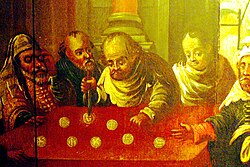
Back Hostienfrevel ALS Hostienfrevel German Profanación de la hostia Spanish Accusation de profanation d'hosties contre les Juifs French חילול לחם הקודש HE Penodaan hosti ID Profanação da hóstia Portuguese Осквернение гостии Russian Hostieskändning Swedish

Host desecration is a form of sacrilege in Christian denominations that follow the doctrine of the real presence of Christ in the Eucharist. It involves the mistreatment or malicious use of a consecrated host—the bread used in the Eucharistic service of the Divine Liturgy or Mass (also known by Protestants simply as Communion bread). It is forbidden by the Catholic, Oriental Orthodox, and Eastern Orthodox Churches, as well as in certain Protestant traditions (including Anglicanism, Lutheranism, and Methodism). In Catholicism, where the host is held to have been transubstantiated into the body of Jesus Christ, host desecration is one of the gravest sins. Intentional host desecration incurs the penalty of excommunication latae sententiae.[1][2] Throughout history, a number of groups have been accused of desecrating the Eucharist, often with grave consequences due to the spiritual importance of the consecrated host.
Accusations against Jews were a common reason given for massacres and expulsions throughout the Middle Ages in Europe.[3] Similar accusations were made against Muslims,[4] Protestants[5] and in witchcraft trials; witch-hunter's guides such as the Malleus Maleficarum refer to hosts as being objects of desecration by witches.[6] It is part of many descriptions of the Black Mass, both in ostensibly historical works and in fiction.[7]
- ^ "Code of Canon Law #1367". Archived from the original on 2019-09-11. Retrieved 2019-09-03.
- ^ "Code of canons of Oriental Churches #1442". Archived from the original on 2019-08-04. Retrieved 2019-09-03.
- ^ "Desecration of the Host". www.jewishencyclopedia.com. Archived from the original on 4 June 2011. Retrieved 7 May 2007.
- ^ David M. Freidenreich (2022). "Muslims Killed Christ!? Theological Arguments and Political Agendas". Jewish Muslims: How Christians Imagined Islam as the Enemy. Oakland, California: University of California Press. pp. 162–3. ISBN 9780520975644. LCCN 2022017143.
- ^ Károly Goda (2014). "Metamorphoses of Corpus Christi: Eucharistic Processions & Clashes in Fifteenth- and Sixteenth-Century Vienna". Theatrum Historiae. 15: 28–31.
- ^ Summers, Montague, ed. The Malleus Maleficarum of Kramer and Sprenger, 1948. Originally in Latin, Germany, 1487. e.g. Part II, Question I, Chapter IV:"...they are bound to observe certain other abominable ceremonies at the command of the devils, such as to spit on the ground at the Elevation of the Host."
- ^ See the studies by: Rhodes, H.T.F. The Satanic Mass, 1954 and Zacharias, Gerhard The Satanic Cult, 1980.